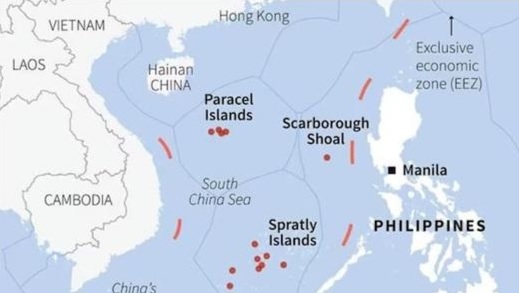(Preliminary Examination: Current Events of National and International Importance, Geography of India and the World)
(Main Examination, General Studies Paper 2: India and Its Neighborhoods - Relations, Impact of Policies and Politics of Developed and Developing Countries on India's Interests) |
Context
Recently, the Chinese Coast Guard hoisted its flag over the disputed Scarborough Shoal on the occasion of National Day and shortly thereafter declared it a nature reserve. The Philippines protested this, calling it a violation of sovereignty. Despite a 2016 ruling against China's claims, China continues to assert its control over the South China Sea. An overview is presented regarding the dispute in the South China Sea.

About Scarborough Shoal
- Scarborough Shoal is a triangular-shaped coral atoll formed on top of a seamount in the eastern part of the South China Sea.
- Both China and the Philippines claim it. It is located approximately 220 km west of the Philippines' Luzon Island.
- It is the largest atoll in the South China Sea, submerged at high tide with only a few rocks protruding from the seafloor.
Related Disputes
- China's Claim: China now calls this shoal Huangyan Island and claims historical authority over the area. According to China, its ownership of the area dates back to the Yuan Dynasty in the 1200s.
- Philippines' Claim: The Philippines claims this area based on geography because it is very close to the Philippines' main island, Luzon, where the capital, Manila, is located, but it is located more than 500 miles from China.
- Based on the 1982 United Nations Convention on the Law of the Sea (UNCLOS), it is considered to be within the Philippines' 200-nautical-mile exclusive economic zone.
- Commercial Importance: The deep waters surrounding the shallows make it a productive fishing area, rich in marine life, and the lagoon also contains many commercially valuable shellfish and sea cucumbers.
Issues Related to China's Conflicts with Other Countries in the South China Sea
China-Philippines Dispute
- Spratly Islands: In addition to Scarborough Shoal, the Spratly Islands are also a point of contention. This archipelago includes numerous small islands, reefs, and atolls.
- These islands are located near strategically important shipping lanes and are believed to be rich in natural resources.
- Establishing a military presence on these islands could allow China to project power in the South China Sea and deter rival claimants from challenging its hegemony.
China-Vietnam Dispute
- The Paracel and Spratly Islands are surrounded by rich fishing grounds and potentially also contain gas and oil reserves. These are at the center of territorial disputes between China and Vietnam.
- Paracel Islands: Located near Vietnam, the Paracel Islands have been under Chinese control since a brief military conflict in 1974. These islands are strategically important due to their proximity to major sea lanes and potential underwater resources.
- Control over the Paracel Islands allows China to expand its military reach and secure its southern maritime borders.
- Spratly Islands: Both China and Vietnam claim parts of the Spratly Islands. Vietnam claims that its sovereignty over the islands has been established in accordance with international law since at least the 17th century.
- China, on the other hand, has stated that it was the first country to discover, name, develop, and manage these islands and archipelagos.
- China's ongoing militarization of these islands serves to strengthen its strategic depth in the region. This militarization is a clear indication of China's intention to project power in the South China Sea.
China-Malaysia Dispute
- China's claims overlap with Malaysia's Exclusive Economic Zone (EEZ), particularly around the Luconia Shoals, an area rich in natural gas and oil.
- By establishing control over these areas, China aims to secure vital energy resources and influence Malaysia's maritime activities.
- This control is crucial for China's long-term energy security and economic development.
Brunei-China Dispute
- Although Brunei's territorial claims are comparatively smaller, they are equally important due to its resource-rich EEZ.
- China's claims in this region are part of a broader strategy to dominate the South China Sea's resource base, ensuring that China can leverage these assets for economic and strategic purposes.
China and Indonesia's Claims on the Natuna Islands
- China's claims in the southern reaches of the South China Sea overlap with Indonesia's EEZ surrounding the Natuna Islands. This region is known for its large hydrocarbon reserves.
- By advancing its claims here, China seeks to expand its influence and secure additional energy resources, which are vital for its economic development and military modernization.
Taiwan: A Key Stakeholder in the South China Sea
- Although Taiwan is not a formal claimant in disputes in the region, its position is inherently linked to China's ambitions.
- China views Taiwan as a breakaway province that must be reunified with the mainland, by force if necessary.
- Control over the South China Sea, particularly areas around Taiwan, provides China with a significant strategic advantage, increasing its ability to project power and potentially isolate Taiwan from international support.
9-Dash Line
- China's claims in the South China Sea are primarily contained within the 9-Dash Line, a demarcation line first introduced on Chinese maps in the early 1950s.
- This line extends more than 2,000 km from the Chinese mainland, encircling almost the entire South China Sea and overlapping with the EEZs of several Southeast Asian countries.
- China continues to aggressively assert its claims despite a 2016 ruling by the Hague-based Permanent Court of Arbitration rejecting the 9-Dash Line.
China's Strategy for Regional Hegemony
- China's territorial disputes in the South China Sea are not isolated incidents, but part of a broader strategy to establish regional dominance.
- Control over this region allows Beijing to secure vital sea lanes, access vast natural resources, and expand its military reach.
- Every territorial claim, from Scarborough Shoal to the Natuna Islands, fits into China's grand design of regional hegemony.
- The recent interception of a Philippine supply plane is a stark reminder of the ongoing struggle for control of the South China Sea.
India's Growing Involvement in the South China Sea
- Given the rising tensions in the South China Sea, India is concerned that the tensions could escalate into war, threatening its dominance in the Indian Ocean.
- As a result, India has attempted to increase its presence in the South China Sea to prevent tensions from spilling into the Indian Ocean, a sphere of traditional influence for India.
- In May 2019, the Indian Navy conducted joint exercises in the South China Sea for the first time with the navies of the United States, Japan, and the Philippines.
- In August 2021, the Indian Navy conducted military exercises with the navies of Vietnam, the Philippines, Malaysia, Australia, and Indonesia.
- In May 2023, India sent warships to participate in a two-day joint exercise with the navies of seven ASEAN countries in the South China Sea for the first time.
- India has also significantly increased its military sales and assistance to the Philippines and Vietnam.
- In January 2022, India signed an agreement with the Philippines for the export of 100 BrahMos supersonic anti-ship missiles.
- In June 2023, Vietnam became the first country to receive a fully operational light missile frigate from India.
- Three factors: strategic interests, freedom of navigation, and oil and gas resources determine India's expanded involvement in the South China Sea.
- India views the South China Sea as a base to advance its 'Act East Policy' and balance China's expansion in the Indian Ocean and its aggression along the China-India border.
- Half of India's foreign trade passes through the Strait of Malacca, so free and secure navigation in the South China Sea is key to India's trade security.
- Unlike the US, India lacks a strong alliance and military presence in the South China Sea, which essentially limits its direct involvement.



